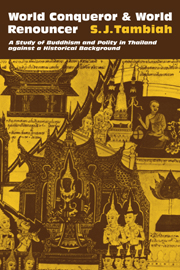 World Conqueror and World Renouncer
World Conqueror and World Renouncer Book contents
- Frontmatter
- Contents
- Acknowledgments
- PART ONE
- 1 Introduction: Reconstructing a Journey
- 2 From Rajadharma (the King's “Whole Duty”) to Dharmaraja (the “Righteous Ruler”)
- 3 The Brahmanical Theory of Society and Kingship
- 4 The Early Buddhist Conception of World Process, Dharma, and Kingship
- 5 Asoka Maurya: The Paradigm
- 6 Thai Kingship and Polity in Historical Perspective
- 7 The Galactic Polity
- 8 The Kingdom of Ayutthaya: Design and Process
- 9 Asokan and Sinhalese Traditions Concerning the Purification of the Sangha
- 10 The Sangha and the Polity: From Ayutthaya to Bangkok
- 11 The Nineteenth-Century Achievements of Religion and Sangha
- 12 The Sangha Acts of 1902, 1941, and 1963
- PART TWO
- Bibliography
- Index
8 - The Kingdom of Ayutthaya: Design and Process
Published online by Cambridge University Press: 10 November 2010
- Frontmatter
- Contents
- Acknowledgments
- PART ONE
- 1 Introduction: Reconstructing a Journey
- 2 From Rajadharma (the King's “Whole Duty”) to Dharmaraja (the “Righteous Ruler”)
- 3 The Brahmanical Theory of Society and Kingship
- 4 The Early Buddhist Conception of World Process, Dharma, and Kingship
- 5 Asoka Maurya: The Paradigm
- 6 Thai Kingship and Polity in Historical Perspective
- 7 The Galactic Polity
- 8 The Kingdom of Ayutthaya: Design and Process
- 9 Asokan and Sinhalese Traditions Concerning the Purification of the Sangha
- 10 The Sangha and the Polity: From Ayutthaya to Bangkok
- 11 The Nineteenth-Century Achievements of Religion and Sangha
- 12 The Sangha Acts of 1902, 1941, and 1963
- PART TWO
- Bibliography
- Index
Summary
We shall now focus on the Ayutthayan kingdom in order to elaborate further a few critical features that we have come to associate with the galactic polity. Ayutthaya, by virtue of its larger magnitude when compared with Sukhodaya and its alleged utilization of political concepts and blueprints of Cambodian origin, contributes more complex features to the structure and form of the galactic polity than did Sukhodaya.
Wales' account (1934) of Siamese government and administration – centered primarily on Ayutthaya – rests on the historical supposition that it was during the rule of King Paramatrailokanatha (1448–1488) that a “great metamorphosis” in the system of government was achieved: A new system of ranking and administrative organization was introduced as a result of Khmer influence, and the conversion of “feudal nobles into government officials took place” (p. 33). Wales emphasizes that the reforms were made possible “by the influx of Khmer officials and literati after the sack of Angkor Thom by King Paramaraja in a.d. 1431” (p. 70).
While we can accept that Ayutthayan administration and political conceptions show an elaboration in the second half of the fifteenth century (as evidenced by the Palatine Law of 1458 and the Laws of Civil and Military Hierarchy of 1454), we should not think that Khmer influence suddenly flooded Ayutthaya for the first time with the conquest of Angkor. Khmer influence was a longstanding and deep-seated one in the whole region from pre-Sukhodaya and pre-Ayutthaya times, the local kingdoms having themselves been at various times Khmer provinces.
- Type
- Chapter
- Information
- World Conqueror and World RenouncerA Study of Buddhism and Polity in Thailand against a Historical Background, pp. 132 - 158Publisher: Cambridge University PressPrint publication year: 1976


